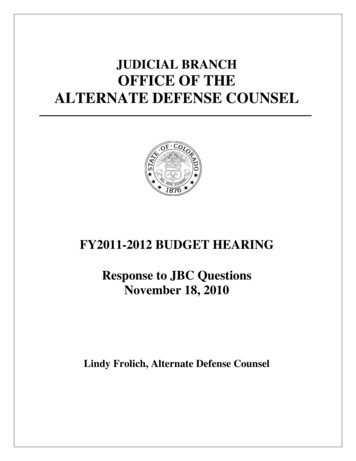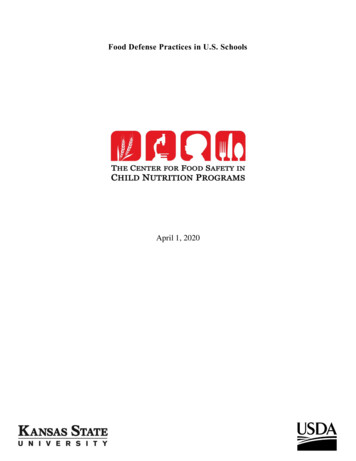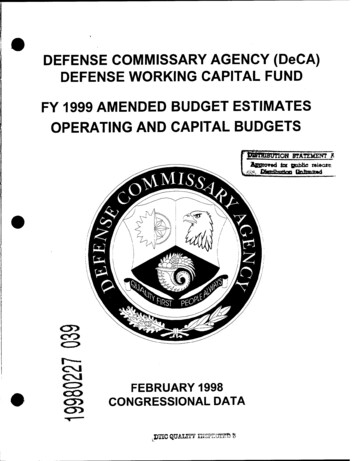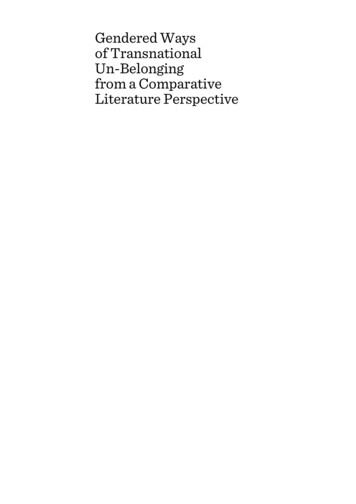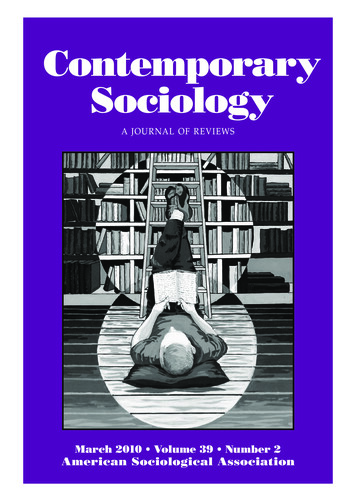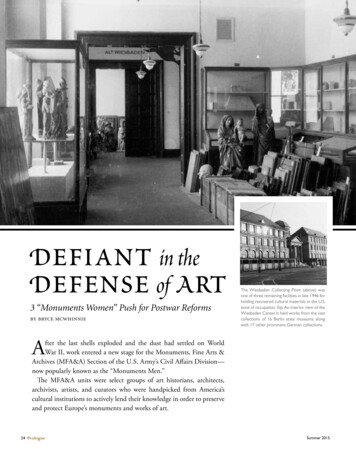
Transcription
Defiant in theDefense of Art3 “Monuments Women” Push for Postwar Reformsby bryce mcwhinnieThe Wiesbaden Collecting Point (above) wasone of three remaining facilities in late 1946 forholding recovered cultural materials in the U.S.zone of occupation. Top: An interior view of theWiesbaden Center. It held works from the vastcollections of 16 Berlin state museums alongwith 17 other prominent German collections.After the last shells exploded and the dust had settled on WorldWar II, work entered a new stage for the Monuments, Fine Arts &Archives (MFA&A) Section of the U.S. Army’s Civil Affairs Division—now popularly known as the “Monuments Men.”The MFA&A units were select groups of art historians, architects,archivists, artists, and curators who were handpicked from America’scultural institutions to actively lend their knowledge in order to preserveand protect Europe’s monuments and works of art.24 PrologueSummer 2015
Most enlisted voluntarily, several braving the front lines without machineguns or adequate supplies, overcoming the odds stacked against them to protect defenseless works of art from devastation and preserve Europe’s culturalpatrimony during the war.After the war in Europe ended in May 1945, the MFA&A’s attentionfocused on the restitution of everything that had been displaced by the Nazis’obsession with art. Repositories were found in castles and salt mines, manyoverflowing with looted art. Under direction from Gen. Dwight D. Eisenhower’s headquarters, the MFA&A established collecting points within theU.S. zone of occupation to safeguard millions of objects while they wereinvestigated and prepared for eventual repatriation to their home countries.By the end of 1946, only three of the main central collecting points remained:Munich, Offenbach, and Wiesbaden. Through these collecting points passedEurope’s greatest cultural treasures. Entireart reference libraries and photography studios were assembled on-site to aid in theanalysis of incoming inventory. Conservation laboratories cared for works at greatestrisk. Every possible resource was exhaustedin order to return items home in the swiftestand most favorable condition.Valland was in constantdanger . . . Nazi officials. . .would have surelyRose Valland’s Detailed RecordsKey to Finding Looted Artworkkilled her had they knownthe depth of her espionage.The MFA&A was established in 1943 by theAmerican Commission for the Protection and Salvage of Artistic and HistoricMonuments in War Areas, known as the Roberts Commission for its chairman,Supreme Court Justice Owen Roberts.While the vast majority of MFA&A officers were male, a few “MonumentsMen” were female. Many of these young American women entered the warthrough the Women’s Army Auxiliary Corps (WAAC) and the Women’s ArmyCorps (WAC) before applying for coveted posts in the MFA&A at the war’s end.Yet, American women have been largely absent from recent World War II–era cultural heritage scholarship. The most prominent woman afforded consistent mention has been Rose Valland, the French heroine at the Jeu de Paumemuseum. As the artistic patrimony of France passed through the doors of theJeu de Paume, she eavesdropped on German conversations and secretly keptmeticulous notes on the destinations of train shipments.Defiant in the Defense of ArtPrologue 25
She witnessed the frequent shopping tripsof Hermann Göring in his selection of lootedart for both Adolf Hitler’s planned museumat Linz and his own vast personal collection.Her records produced a paper trail that led tonot only the enormous cache of looted art atNeuschwanstein Castle in Bavaria, but also thediscovery of further repositories and the eventual return of France’s greatest treasures. Vallandwas in constant danger of being discovered byNazi officials, who would have surely killed herhad they known the depth of her espionage.However, there were three unsung femaleAmerican MFA&A officers, who, like Valland, put their personal interests in jeopardyin order to protect priceless art. Capt. EdithA. Standen, Evelyn Tucker, and Capt. Mary J.Regan all entered service under the age of 40,and each of these women left her own markon postwar cultural heritage restitution policy.Each held a firm belief in justice for art inoccupied territories, and they all possessedthe courage to act in defiance of a practicethey found morally intolerable. Standen,Tucker, and Regan each recognized anopportunity to reform post–World War IIrestitution policy and defied their superiorsfor the common good of cultural heritageprotection.These are their stories.Capt. Edith A. Standen:A Woman on the Way UpCapt. Edith A. Standen was the only womanto sign the Wiesbaden Manifesto on November 7, 1945. Called “the only act of protestby officers against their orders in the SecondWorld War,” it denounced the U.S. Government’s decision to transfer 202 paintingsfrom the Wiesbaden Central CollectingPoint in Germany to the National Galleryof Art in Washington, D.C., for safekeeping.Capt. Edith Standen (left) with Rose Valland at Wiesbaden. Standen was named officer-in-charge in March1946. Valland had spied on Nazi transport of Frenchartworks through the Jeu de Paume, and her secretnotes on the destinations of train shipments helpedwith later restitution work.26 PrologueDuring her work with the MFA&A, Standen rose through the ranks from second lieutenant in the Women’s Army Auxiliary Corpsto officer-in-charge at Wiesbaden—all withinthree years. She worked closely with Valland (bythen an art representative with the French FirstArmy) at Wiesbaden, and the two developed areal camaraderie while Standen was director.Standen’s academic experience directly prepared her for a prolific career in the MFA&A.An Oxford graduate, she worked for theSociety for the Preservation of New England Antiquities before studying at the FoggMuseum at Harvard University under PaulSachs, future prominent member of the Roberts Commission. Just one year after becoming an American citizen, in early 1943, shejoined the Women’s Army Auxiliary Corps.After being referred to MFA&A officer andHarvard professor Mason Hammond, shewas selected as a fine arts specialist officer inJune 1945. One of her first assignments wasto inspect the art objects being held at theReichsbank in Frankfurt—the same objectsthat would later be transferred to the Wiesbaden Collecting Point when it opened. BySeptember 1945, she was transferred again tothe G-5 Division of the European Theater ofOperations. After her promotion to captain,she was named temporary officer-in-chargeof the Wiesbaden Collecting Point upon theredeployment of its former director, Capt.Walter I. Farmer, in March 1946.Standen described setting up a collecting point as “an almost superhuman task.”Established in 1945 by Farmer to be the central collecting point for all German-ownedworks of art, Wiesbaden held works fromthe vast collections of 16 Berlin state museums along with 17 other prominent German collections.Perfectly Working UnitReceives a Major JoltFarmer recruited an American architect,a photographic team, conservators, andadministrators to document and care for the
artworks. The Wiesbaden Collecting Pointwas a well-oiled machine that stood as asymbol of success for the MFA&A. Standenlater remarked that, when she later took overfor Farmer, she inherited “an organization inperfect working order.”Farmer established extensive security measures at the collecting point, and the staff wasdedicated to the safety and integrity of theobjects under their care. It therefore came asa serious blow when Farmer was hand-delivered a telegram received from Seventh U.S.Army headquarters on November 6, 1945.The telegram ordered “immediate preparations be made for prompt shipment to the U.S.of a selection of at least two zero zero (200)German works of art of greatest importance.”The order was the product of a secret plan inthe works for months, personally approved byPresident Harry S. Truman as early as July.Because “neither expert personnel nor satisfactory facilities are available in the U.S. zoneto properly safeguard and handle these priceless works of art,” argued Gen. Lucius Clay,the deputy military governor of Germany,they must be sent to the United States, wherebetter resources and personnel were available.Clay divided Germany’s works of art intothree classes and supplied his recommendations for their respective fates: Class A (artseized by Germany from countries or privateowners without compensation), Class B (arttaken from private collectors with some level ofcompensation), and Class C (art placed withinthe U.S. zone by Germany for safekeeping).While Classes A and B should be returnedto their original owners, Class C was considered German public property. Therefore,these works of art fell under U.S. control andshould “be returned to the US to be inventoried, identified, and cared for by our leadingmuseums” and “be placed on exhibit in theUS.” Chillingly, Clay added that these worksof art would be “held in trusteeship for returnto the German nation when it has re-earnedits right to be considered as a nation.”The National Gallery of Art in Washington, D.C, was inevitably chosen as the safeDefiant in the Defense of ArtCapt. Walter I. Farmer organized Wiesbaden into an effective center that included conservators, photographers, and administrators. He opposed the shipment of 200 works of art to the National Gallery by gatheringstaff signatures on a document known as the Wiesbaden Manifesto.haven for these objects: the gallery housedthe headquarters of the Roberts Commission,while its board of trustees included the chiefjustice of the United States, the secretary ofstate, and the secretary of the treasury.Eisenhower’s AdvisersWere Never ConsultedThe MFA&A, along with the Roberts Commission back in Washington, was not initiallyconsulted about the plan to move German artto the United States. When word finally didreach the MFA&A at its Frankfurt headquarterson July 29, 1945, Lt. Col. Mason Hammondimmediately protested to headquarters. In addition, he defied the order of secrecy regarding theplan and relayed a copy of Clay’s memorandumto the director of political affairs.Also never consulted on the plan wasJohn Nicholas Brown, Eisenhower’s adviseron cultural matters, who sent multiple letters pleading for the plan to be abandoned.His August 9 letter to Clay is a line-by-linedeconstruction of the original memorandum, in which he references Clay as being“under a grave misapprehension” for doubting the MFA&A’s quality, while calling theplan “manifestly impossible” and “not onlyimmoral but hypocritical.” (Brown’s son, J.Carter Brown, was the National Gallery’sdirector from 1969 to 1992.)Such protestations were ignored, and theNational Gallery sent its representative, Col.Henry McBride, to Wiesbaden to supervisethe shipment. Standen was ordered to submit information on the masterpieces at theMarburg and Wiesbaden collecting points.Wholeheartedly objecting to the plan,Standen put minimal effort into herresponse. She listed “only things I saw withmy own eyes, gave them fifteen paintings. . . all belonging to museums outside ourzone. I rather hated doing it.” Yet, in a quietvictory for the MFA&A, one of their ownofficers (and former National Gallery staffmember), Lt. Lamont Moore, was chosento accompany the shipment. It is clear fromtheir correspondences that Moore was a dearfriend of Standen’s, and the two valued andtrusted each other’s opinion throughouttheir respective careers with the MFA&A. Itwould have come as a comfort to her andher colleagues that Moore accompanied theworks of art to the United States.Colonel McBride, along with Moore andMaj. L. Bancel LaFarge (chief of the MFA&Asection of the Seventh Army under GeneralClay), arrived at Wiesbaden on November 7,1945. The official order called for “at least 200”works of art to be packed and ready for shipmentby November 20. The numerous MFA&A officers were powerless to stop the shipment, andtheir mood was palpable. Standen mentionedPrologue 27
Eyck (5), Lorenzetti (2), Holbein (3), Rubens(6), Masaccio (3), Lippi (2), Verocchio (2), Poussin (2), Velasquez (2), and Vermeer (2). For theMFA&A, the dangerous shipment of such anincredible collection overseas for no legitimatereason was inconceivable.Most MFA&A OfficersSign Wiesbaden ManifestoAbove: Workers at Wiesbaden open crates and inspect artworks. Edith Standen and Rose Valland observe in the back.Below: Part of the list of artworks sent from Wiesbaden to the National Gallery in Washington, D.C., showsworks by such masters as Lucas Cranach the Elder and Jan Van Eyck. The collection also included works byRembrandt, Raphael, and Rubens.“the state of utter misery we are all in now” andeven that “Col. McBride has threatened us all(in a nice way) with court martials.”Though the National Gallery’s original wish listincluded items from multiple collecting points,the many complications of such an involvedshipment forced McBride to limit his selectionto Wiesbaden. The final list of 202 paintings28 Prologuereveals the staggering importance of this collection to not only the German public but toEurope as a whole. The shipment included worksby Caravaggio (1), Manet (1), Fra Angelico (1),Hals (6), Giotto (1), Tintoretto (2), Tiepolo (3),Titian (5), Rembrandt (14), Bronzino (3), Giorgione (1), Botticelli (6), Raphael (3), Watteau (3),Van der Weyden (5), Dürer (5), Bruegel (2), VanFarmer invited the 35 MFA&A membersavailable in Europe to assemble in his officeon November 7. There, Capt. Everett Lesleypenned the five paragraphs that became knownas the Wiesbaden Manifesto. Though not allmade it to Wiesbaden on such short notice, 32officers ultimately gave their names in supportof the protest. Of these, 24 signed with theirofficial signatures, three gave their names as anexpression of agreement but did not “feel at liberty to sign,” five officers were listed as havingsent private letters to LaFarge, and the remaining three could not be contacted in time.This internal revolution was “the only act ofprotest by officers against their orders in theSecond World War,” Farmer later wrote. Thedocument was sent to LaFarge at MFA&Aheadquarters. In the interest of protecting hisfriends and colleagues, he hid it in his desk andnever sent it on. Nevertheless, after returningto his teaching post at Harvard, Lt. CharlesKuhn published the Wiesbaden Manifesto inthe January 1946 issue of College Art Journal.Kuhn’s article, combined with multiplereports on the transfer in the American press,sparked a heated ethical debate that did notfade until the 202 paintings were eventuallyreturned to Wiesbaden after a blockbusterexhibition in Washington and a national tourto 13 American cities.The third paragraph of the document speaksof the declared Western Allied responsibility to“protect and preserve from deterioration . . . allmonuments, documents or other objects of historic, artistic, cultural or archaeological value.”Later, in her own words, Standen remarkedthat: “The greatest priority to us was the wellbeing of art of all kinds and of any ownership.”Summer 2015
Artworks are returned to Wiesbaden in 1949 after being exhibited at the National Gallery in Washington, D.C.,and in 13 other American cities.In addition to their concerns for the safetyof art, Standen and the other supporters of theWiesbaden Manifesto believed that a large-scaleremoval of German art to the United Stateswould forever damage the integrity of the Alliedmission to protect cultural heritage. In September 1945, Hammond had warned on behalf ofthe entire MFA&A that the shipment wouldalign the United States with the Nazis, “whoequally used the pretexts of protection and ofthe unsuitability of other nations to own artobjects to justify their looting of art objects.”National Gallery Plan SeenAs Bad for U.S. RelationsAfter the shipment left Wiesbaden, American MFA&A officers found it hard to facethe workers at the collecting points. “Youcan’t imagine how hard it is to justify in theeyes of other people something that youthink horrible,” Farmer remarked.In their protest, the supporters of the Wiesbaden Manifesto referenced the prosecutionsof individuals for art crimes during the war—namely those who seized German-owned artunder pretext of “protective custody.”They powerfully pointed out that much ofthe indictment of these criminals rested on theAllied belief that “even though these individuals were acting under military orders, the dicDefiant in the Defense of Arttates of a higher ethical law made it incumbentupon them to refuse to take part in, or countenance, the fulfillment of these orders.” Painfully aware of the hypocrisy of the situation,they called themselves “no less culpable thanthose whose prosecution we effect to sanction.”Standen’s signature is the seventh on theWiesbaden Manifesto. She continued to distribute copies to various offices with a personally signed cover letter nearly a monthafter the paintings had left Wiesbaden. Astemporary officer-in-charge of the Wiesbaden Central Collecting Point, she oversawthe restitution of thousands of art objects.Standen is the only female member ofthe Roberts Commission to have earnedthe Bronze Star for her service, as did 10fellow signees of the Wiesbaden Manifesto.In 1997, just a year before her death, shereferred to her role in the MFA&A as “adwarf standing on the shoulders of giants.”In her character, devotion to her task, andher belief in justice, Edith A. Standen wasanything but dwarflike. Certainly, she wasone of the giants.Evelyn Tucker: A WomanCommitted to ActionThe most outspoken female voice in post–World War II cultural heritage restitutionwas Evelyn Tucker. She harbored an opinionon everything, and she voiced each conviction without apology or frills.After joining the WAC, she was a secretary/stenographer at Hermann Göring’s war crimestrial before the International Military Tribunalin Nuremberg. She was then the administrativeassistant at the Reparation, Deliveries, and Restitution Branch in Salzburg, Austria, upon itsactivation in February 1946. Tucker was latera Fine Arts representative with the RD&R,keeping inventory records of the branch’s artobjects and personally investigating countlessrestitution claims within the jurisdiction of theU.S. Forces, Austria (USFA).Her many field reports reveal a womanwho never stopped moving. One detailedweekly report mentions the shipment of scientific skeletons stolen from the Universityof Strasbourg, a search for a person of interest across six neighboring villages, and a tripto the art depot to examine a set of paintings—all before taking the Friday afternoontrain to Linz under a “pea-soup fog.”While she worked with the MFA&A, Tuckerrecognized many shortcomings in its policy andorganization and committed herself to theirreform. She blatantly reported the missteps andmismanagement of her superiors and activelyinvestigated the hushed subject of looting byAmerican officers. She criticized what she sawas a disorganized and confusing plan for restitution, setting many of her colleagues against herand eventually costing her the position.Her piéce de résistance is her Final Status Report filed February 16, 1949, afterher position was terminated. In the report,Tucker levies many complaints against theArmy, which in her opinion blocked her everypath and never afforded her the support sherequired to finish her job. From her words, itis clear that she was long past mere frustrationand had crossed into the realm of disgust.On the first page alone, she sarcasticallyrefers to the Army’s treatment of her as “amatter of regret” and sees her dismissal as anomen of their “deplorable” approach to thework only she was qualified for.Prologue 29
Evelyn Tucker, working in the U.S. Zone of Austria, was highly critical of the MFA&A program in her final reportof February 16, 1949. The Army “did not attach enough importance” to her work, she wrote, to enable her to“bring it to a successful conclusion.”She makes a final plea for improvement inthe Army’s treatment of the Austrian monuments agencies with whom she had painstakingly built a strong working relationship. Shedramatically warns that, if relations are notimproved, “you will discover that a nation isextremely jealous of its cultural heritage andthese offices will work against you instead ofwith you.” While one could read this 31-pagereport with raised eyebrows and see naughtbut a woman past her breaking point, it is notthe measure of the woman.Rather, Tucker’s entire career with theMFA&A was laced with defiance.Tucker Seeks to BringReform in AustriaAs a representative of the MFA&A withinthe USFA, Tucker traveled widely across the30 PrologueU.S. zone of occupation. She collaboratedwith various foreign agencies and witnessedfirsthand the delicate balances of powerinvolved in sending art objects home. Yetshe quickly became frustrated with what shesaw as an inefficient and confusing methodfor restitution—intensified by an endlessweb of protocols and jurisdictional disputes.In her field reports, she highlights thesedeficiencies and confidently gives her opinions for reform. Of particular frustrationwas her weeklong visit to the Munich Central Collecting Point in early February 1948.She discovered that looted paintings were notfiled under a specific artist’s name but werecategorized by the claimants, and one neededthat name in order to find a specific work.Tucker mentions that a search as specific as“Dutch Government, claim no. 10” was notsufficient. Trying to find items on her list ofAustrian claims, she sifted through lists andrecords to create an inventory of how manystill remained in Munich. Tucker tiredlyremarks that she “can only make a wild guess asto what we still have there . . . certainly in thethousands, with values running into the millions.” She later returned to Munich on August9, and established the procedure for Austrianitems to be segregated into five categories tomake their return easier.Also at Munich, Tucker experienced firsthand the emotional roadblocks to Austrian artrestitution, which Herbert Stewart Leonard,director of the center, called “political dynamite.” The 160 German workers at the centerhad recently handed Leonard a 45-page protest of the center’s restitution policy by way ofa chief staff officer, who then resigned.The German workers vehemently believedthat Austria had no right to restitution unlessit could prove the objects had been confiscatedor taken under duress. Tucker angrily wrotethat such prejudicial sentiments were “developing from an attitude into policy.” Furthermore, Germany had no “moral right (not tomention orders from Washington)” and thatthe whole situation was “unanswerable.”Tucker’s Field Reports RevealSharp Differences with SuperiorsTo reform these prejudices and ease the restitution effort, Tucker sent notes to Leonard,reminding him of the USFA position on finearts matters. As the chief of the MFA&A sectionfor Bavaria, Leonard held the precarious role ofrepresenting both the commanding generalof the USFA and the commanding general ofthe Office of Military Government for Bavaria(OMGB). As director of the collecting point inMunich, he was regularly caught in the middleof intense jurisdictional disputes.Despite Leonard’s superior rank, Tucker madeit her business to stand up for the best interests ofAustrian cultural heritage. In her notes, she references his power to sign USFA receipts out ofMunich as “a dual capacity” and reminds him ofthe directive from the Joint Chiefs of Staff. ThisSummer 2015
mandate established the policy that any fine artsremoved from Austria between March 13, 1938,and May 15, 1945, were to be returned withoutquestion and regardless of the nature of their sale.Tucker’s field reports detail her tumultuous working relationship with Leonard, whichfinally reached its peak with his dramaticallyphoning in his resignation to headquarters during one of their arguments. She states that theyhad become “two operators working largelyfrom the same pot, under different directives.”In her work to reform postwar restitution policy, Tucker was not afraid to report the misstepsof her superiors and fellow MFA&A officers.She mentions her frustration at her superiors’unauthorized restitutions out of the Salzburgwarehouse as well as their many inconsistenciesin protocol. Many times, she would clear an artobject for restitution but later discover that itremained in the vault rooms.At Schloss Fischhorn she tried tountangle “the errors caused by MFAofficers” such as why two paintingsremained at the castle despite havingbeen listed on a transport receipt to thePolish government. At the Alt-Ausseesalt mine, over a dozen works inspectedwere listed on conflicting inventories ashaving already left the mine.When a junior officer was falselyaccused of having stolen a number of paintings from the collection of Frederic Wels, itwas a highly publicized embarrassment for theUSFA. Tucker helped investigate the situationand cleared his name. However, she made surethat all blame for the situation was placed on thelieutenant, who “moved things around, mixedthem up and apparently kept little records.” Inher eight-page report on the matter, she declaredthat “he has only himself to thank for the suspicion which has been thrown on him.”tude among some American soldiers thatthey were entitled to such souvenirs as payback for their wartime hardships.In addition, the U.S. Military Detachment took a large chest of 2,500 gold coinsbelonging to the Salzburg Museum fromthe Hallein salt mine. Many high-rankingofficers removed items from repositoriesand property warehouses to furnish theirpersonal offices and apartments. In Tucker’seyes, this was wholly contradictory to themission of the MFA&A and tarnished theinternational public image of the U.S. Army.To further investigate the involvement ofAmerican troops, she made lists of art objectskept in officers’ clubs and the personal offices ofgenerals. Much of her final report is devoted tolisting these items in detail and pressing one lasttime for their return. She reported that Lt. Colo-“What do youwant thisinformation for?”Looting by U.S. TroopsDraws Tucker’s IreTucker was especially vocal in regard to thehushed problem of looting by Americanmilitary personnel. There remained an atti-Defiant in the Defense of Artnel Smith removed seven rugs from Schloss Mitterstill for use in his Salzburg apartment, and fourLouis XV chairs were located in Villa Warsburg,the villa of the commanding general in Salzburg.Through her own investigations, Tuckerbecame incensed that many of the paintings used as décor by American personnelhad already been released for restitution totheir home countries. She lists eight paintings released to the Austrian governmenton December 19, 1947, and 14 released toHungarian agencies on January 5, 1949, allof which still remained in use by the USFAas of her final report in February 1949.In another section labeled “Special Problems,” she exposes the shipment of five truckloads full of “large paintings, large furniture,and objects of art, and huge baroque mir-rors” removed from Stift St. Florian between1945 and 1946 for use in American billets.In these efforts, she was repeatedly obstructed.Many Army personnel had misconceivednotions of the role of restitution officers andtreated them with suspicion and criticism.One colonel cautioned her that his fellow officers “were rather sensitive about their villas anddidn’t like RD&R people coming around andlooking for things or removing them.” The villas,resorts, and clubs of high-ranking officers seemedcuriously off limits. She had been informed of thelocations of many priceless items, such as a Millet painting at Villa Trainblick and a Van Dyck atthe general’s villa in Linz, but no investigationshad been made at these places to determine theprovenance of these objects.She was the first restitution officer admitted into the Nazi guest house turned Alliedofficers’ club, Cavalierhaus, only aftersecuring written permission from thechief of staff in Salzburg. Tucker againsaw no logic in this. She called the inaccessibility of these collections to fine artsofficers “reprehensible.” Her job was tolocate and identify looted objects in theU.S. zone of Austria, but she was, in herown words, “forbidden to check the onebest source.”Tucker’s Job Encounters ManyRoadblocks, Much ResistanceTucker remained remarkably persistentdespite every roadblock set in her path. Sheoften felt overwhelmed, but still she foughtfor her voice to be heard.At every turn, she needed clearance from asuperior or someone else’s signature in orderto act on time-sensitive matters. Tucker writesof having to convince one major to give hera set of unclassified papers after he asked:“What do you want this information for?”Another officer expressed reluctance to signher paper because he wanted to think it overand write to the general. True to form, sherecords her response: “I said I did not see whyGenerals had to become involved.”Prologue 31
In the field, Tucker obsessively trackeddown leads. She pushed and shoved past astubborn housekeeper to gain entrance toSchloss Fischhorn and rooted through theshed in back of Castle Leopoldskron to seeher investigations through to the end.Her outspoken nature caused many todecide she was difficult to work with, andher relentless meddling set the U.S. Armyagainst her. Yet, for Tucker, these were worthy sacrifices for a cause that needed a champion. In persistence and passion, she was anunmatched force that could not be silenced.Mary J. Regan’s ResearchAids Officers in the FieldSimilar frustrations and roadblocks werealso encountered by Mary J. Regan, a Harvard graduate and captain in the Women’sArmy Corps. After working as a high schoolart teacher, she enlisted in July 1942 anddevoted herself to tireless action in the WAC.At the war’s end, she quickly volunteered for service with the MFA&A and wasassigned the p
tect defenseless works of art from devastation and preserve Europe's cultural patrimony during the war. After the war in Europe ended in May 1945, the MFA&A's attention focused on the restitution of everything that had been displaced by the Nazis' obsession with art. Repositories were found in castles and salt mines, many




